1. Hunting to extinction or near-extinction
As omnivores, humans have always hunted animals for food (or other animal parts, such as skins, bones, guts, or horns). In terms of biodiversity, this is only a problem when hunting becomes overhunting.

In recent times, overhunting has led to the extinction or near extinction of dozens of animals. Here are a few examples.
The American Bison. During the 1800s, their numbers were reduced from 60,000,000 to just a few hundred animals by 1900. (source: wikipedia). Under subsequent protection, they now number about 500,000.
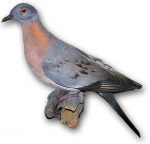
The Passenger Pigeon. A North American bird called the passenger pigeon was once thought to be the most abundant bird in the world. Witnesses from the 1800s reported how it could take hours for a single flock to pass overhead. Overhunting led this species to become extinct in 1914, when the last surviving Passenger Pigeon died in the Cincinnati Zoo.
Other animals that have become extinct because of overharvest include:
- The Stellar’s Sea Cow (a northern relative of the manatee, extinct since 1768)
- The Bubal Hartebeest (an antelope that lived in Northern Africa and the Middle East, extinct since the mid-1900s).
- The Pyrenean Ibex (a wild goat that lived in the Pyrenees Mountains between Spain and France, extinct since 2000).
- The Western Black Rhino. This rhinoceros population was hunted to extinction within the last decade. Rhinos are killed for their horns, which are used in traditional Chinese and Vietnamese medicine. There are five existing rhinoceros species, and all are endangered.
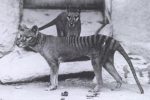
Animals that have been killed for predator control include:
- The Grizzly Bear: The last Grizzly in California was killed in 1922. Ironically, California’s official animal is the Grizzly bear.
- The Gray Wolf: The gray wolf was wiped out in the lower 48 states in 1926. However, wolves were reintroduced into Yellowstone National Park in 1995.
- The Tasmanian Wolf: The Tasmanian wolf, which lived in New Guinea, Australia, and Tasmania, became extinct in the 1930s.
While there’s a growing movement for sustainable fishing, many fish stocks have been overexploited. According to the Food and Agriculture Organization of the United Nations, “the state of marine fishery resources…has continued to decline.” Whereas the proportion of sustainable fish stocks was 90% in 1974, that number fell to 65.8% in 2017.
2. Introduced/Invasive Species
Introduced species (also known as non-native or exotic species) are species that were moved intentionally or accidentally from one location to another. In that new area, freed from the controls that kept their population in check, they often grow exponentially. If that’s the case, they become biological invaders: invasive species.
Here are a few traits commonly found in invasive species.
- A high rate of reproduction.
- Fast development from juvenile to adult.
- Highly adaptable.
- For animals: able to live off a wide variety of food sources
- For plants: able to tolerate a wide range of conditions (amount of shade, quality of the soil, etc).
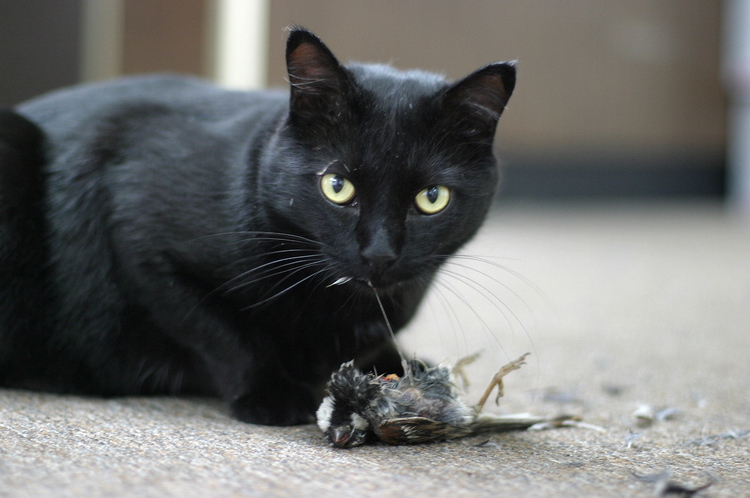
You don’t have to look far to find invasive species. They’re everywhere. If you have a house cat, then you own a particularly destructive invasive species. House cats kill between 1.3–4.0 billion birds and 6.3–22.3 billion mammals annually. While many of the mammals killed are mice and other rodents, house cats are a major threat to birds. These kills are both by pets and feral cats (cats without an owner that live on their own). Source: Nature Communications, The American Bird Conservancy.
Rats are another invasive species. They’re responsible for 40 to 60 percent of all bird and reptile extinctions on islands. (source) The famously extinct Dodo bird of the island of Mauritius, once thought to have been hunted to death by Dutch sailors who first reached the island in the 1600s, was probably done in by rats, which raided Dodo nests and destroyed their eggs.
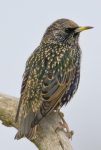
While birds are often the victims of invasive species, certain bird species are also invasive. The European Starling was released into New York’s Central Park by Shakespeare enthusiasts in the 1890s (because starlings are mentioned in Shakespeare’s plays). Now there are 200 million starlings in North America. They compete with native birds for nest sites, and with other insect-eating birds for food.
The House Sparrow, one of the most commonly seen birds in North America, is another invasive bird species. These birds were introduced into Brooklyn, New York, in 1851. Additional introductions occurred in San Francisco and Salt Lake City in the 1870s. Since 1900, they’ve been established in all of the lower 48 states. Like starlings, house sparrows compete with native birds for food and nesting sites.
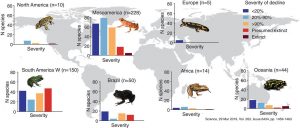
Amphibians are the vertebrates that are experiencing the highest rate of extinction, with over 40% of the world’s 8000 species listed as threatened or endangered. Why? The main cause is an invasive fungal pathogen called Batrachochytrium dendrobatidis (Bd). This fungus infects the frog’s skin, disrupting the frog’s ability to regulate many aspects of its physiology.
Bd has caused declines in 500 amphibian species worldwide, and driven dozens to extinction. The map above shows the extent of amphibian decline worldwide.

Plants can be invasive, too. As they spread, they can overrun entire ecosystems, outcompeting native plants and disrupting food webs, causing biodiversity losses. The image at left shows one invasive plant called kudzu. Kudzu, which originated in Asia, was promoted as an ornamental plant and later grown for forage (food for animals) in the southeastern United States. Millions of acres were deliberately planted to reduce soil erosion in deforested areas. But with an ability to grow up to a foot each day, kudzu has overgrown entire forests.
Invasive species can cause huge agricultural losses.
- The Asian Citrus Psyllid is a gnat-sized insect. It carries a bacterium that causes citrus greening, a disease that kills citrus trees such as oranges, grapefruits, and lemons, all of which are important crops.
- The European Gypsy Moth is originally from France. It was introduced into the United States in the 1890s in a failed attempt to create an American silk industry. Its caterpillars devour budding leaves, which can weaken and kill a variety of trees such as oaks, maples, apples, aspens, willow, birch, and pine. Its relative, the Asian Gypsy moth, has recently been detected in Washington State, Oregon, Oklahoma and South Carolina. With a wider host range than its European cousin, it’s feared that the Asian Gypsy moth could cause significant damage throughout the United States and Canada.
- Cryphonectria parasitica is a parasitic fungus that attacks chestnut trees, causing a disease called chestnut blight. Introduced into the United states in the 1900s, it killed an estimated 4 billion chestnut trees. These trees were habitat for many native species of birds, insects, etc, so that loss of chestnuts had cascading ecological effects.
3. There are many other threats to biodiversity
There are entire courses devoted to learning about threats to biodiversity. The ones listed above are most relevant to an high school biology course. But there are others, including pollution and climate change. One effect of pollutants in the environment is biological magnification, which you can learn about by following the preceding link to our AP-level module on Trophic Levels and Ecological pyramids. If you’re interested in learning more about climate change, you can go to this page for a tutorial about the Greenhouse effect and Climate Disruption.
4. Threats to Biodiversity Part 2: Checking Understanding
4a. Threats to Biodiversity Flashcards.
[qdeck qrecord_id=”sciencemusicvideosMeister1961-Threats to Biodiversity 2 (HS) Flashcards”]
[h]Threats to Biodiversity, Part 2, Flashcards
[i]
The Tasmanian Wolf
[q]REVIEW: The number 1 reason behind the current extinction crisis is
[a]The number 1 reason behind the current extinction crisis is destruction or degradation of habitat.
[q]REVIEW: The image below shows another factor behind the current extinction crisis: ____________________.
[a]The image below shows another factor behind the current extinction crisis: fragmentation of habitat.
[q]REVIEW: Why is fragmentation of habitat a problem. List 3 reasons.
[a]Fragmentation of habitat is a problem for several reasons:
- It degrades habitat by creating too much edge.
- It results in areas with insufficient resources for a population to sustain itself.
- It creates population bottlenecks, resulting in genetically unfit populations.
[q]Animals like the passenger pigeon and the Stellar’s sea cow became extinct through ____________________.
[a]Animals like the passenger pigeon and the Stellar’s sea cow became extinct through overhunting.
[q]Grizzly bears and wolves are under threat (and are locally extinct in many areas) because of ____________________.
[a]Grizzly bears and wolves are under threat (and are locally extinct in many areas) because of overhunting for predator control.
[q]Animals that become invasive species are able to live off of a __________________________. Invasive plants are able to tolerate ___________________. Any invasive species usually has a high rate of ___________________ .
[a]Animals that become invasive species are able to live off of a wide variety of food sources. Invasive plants are able to tolerate a wide range of conditions. Any invasive species usually has a high rate of reproduction.
[q]List two invasive mammal species.
[a]Cats and rats are two invasive mammal species.
[q]List two invasive bird species.
[a]Starlings and house sparrows are two invasive bird species.
[q]What’s causing the massive die off of amphibians?
[a]The massive amphibian die off is being caused by the fungal pathogen Bd.
[/qdeck]
4. Threats to Biodiversity (part 2) Quiz
[qwiz qrecord_id=”sciencemusicvideosMeister1961-Threats to Biodiversity 2 (HS) Quiz”]
[h]Threats to biodiversity, part 2
[i]
The passenger pigeon
[q]The American Bison and the passenger pigeon are examples of species that have suffered from [hangman].
[c]b3Zlcmh1bnRpbmc=[Qq]
[q]California Grizzly bears, the Gray Wolf, and the Tasmanian wolf were hunted to extinction or to the brink of extinction in the name of [hangman] control.
[c]cHJlZGF0b3I=[Qq]
[q]When an introduced species starts to grow exponentially in its new environment, it can become what’s called an [hangman] species. Such species often have very high rates of [hangman].
[c]aW52YXNpdmU=[Qq]
[c]cmVwcm9kdWN0aW9u[Qq]
[q]One of the most destructive invasive species in North America is the [hangman], which is commonly owned as a pet. These animals are responsible for the death of over a [hangman] birds every year.
[c]aG91c2VjYXQ=[Qq]
[c]YmlsbGlvbg==[Qq]
[q]Most invasive animal species
[c]aGF2ZSBhIHZlcnkgc3BlY2lmaWMgZWNvbG9naWNhbCBuaWNoZSwgYW5kIGNhbiBtYWtlIGEgbGl2aW5nIGZyb20gbWFueSBmb29kIHNvdXJjZXM=[Qq]
[c]YXJlIGhpZ2hseSBnZW5lcmFsaXplZCwgYW5kIGNhbiBtYW tlIGEgbGl2aW5nIGZyb20gbWFueSBmb29kIHNvdXJjZXMu[Qq]
[q labels = “top”]The diagram below shows the effect of the fox, which is an invasive species in Australia, upon the quoll, a pouched-mammal that’s native to Australia. Based on the diagram, the quoll is a __________ consumer. Therefore it’s in _____________ with the fox for resources. The fox has a ________ impact on the grasshopper and the dragonfly. It’s effect upon the quoll is ________. Because the fox and the quoll share a large part of their ecological _________, the principle of competitive exclusion suggests that only one of them will survive. Because it can take a _________ variety of prey, the winner of this competition will probably be the fox. Again we see how the effect on an invasive species is to reduce ____________.
[l]biodiversity
[fx] No, that’s not correct. Please try again.
[f*] Great!
[l]competition
[fx] No. Please try again.
[f*] Correct!
[l]direct
[fx] No, that’s not correct. Please try again.
[f*] Good!
[l]indirect
[fx] No, that’s not correct. Please try again.
[f*] Good!
[l]niche
[fx] No. Please try again.
[f*] Correct!
[l]third-level
[fx] No. Please try again.
[f*] Excellent!
[l]wider
[fx] No, that’s not correct. Please try again.
[f*] Great!
[q multiple_choice=”true”]When introduced into a new area, the most likely thing that an invasive species will do is
[c]aW50ZXJicmVlZCB3aXRoIGNsb3NlbHkgcmVsYXRlZCBuYXRpdmUgc3BlY2llcw==[Qq]
[f]Tm8uIEl0JiM4MjE3O3MgdW5saWtlbHkgdGhhdCB0aGUgaW52YWRlciB3b3VsZCBiZSBjbG9zZWx5IHJlbGF0ZWQgZW5vdWdoIHRvIGEgbmF0aXZlIHRvIGludGVyYnJlZWQu[Qq]
[c]aW50ZWdyYXRlIHRoZW1zZWx2ZXMgaW50byBleGlzdGluZyBmb29kIHdlYnMsIGtlZXBpbmcgdGhvc2UgZm9vZCB3ZWJzIGludGFjdC4=[Qq]
[f]Tm8uIFJlbWVtYmVyIHRoYXQgaW52YXNpdmUgc3BlY2llcyBnZW5lcmFsbHkgY2F1c2UgYmlvZGl2ZXJzaXR5IGxvc3Nlcy4gV2hpY2ggb2YgdGhlIGNob2ljZXMgd291bGQgaW5kaWNhdGUgdGhhdD8=[Qq]
[c]Z3JvdyBleHBvbmVudGlhbGx5IGFuZCBv dXRjb21wZXRlIG5hdGl2ZSBzcGVjaWVz[Qq]
[f]TmljZSBqb2IuIEludmFzaXZlIHNwZWNpZXMgdGVuZCB0byBncm93IGV4cG9uZW50aWFsbHkgYW5kIG91dGNvbXBldGUgbmF0aXZlIHNwZWNpZXMu[Qq]
[c]ZGV2ZWxvcCBoZWxwZnVsIHJlbGF0aW9uc2hpcHMgd2l0aCBzcGVjaWVzIHRoYXQgaGF2ZSBzaW1pbGFyIGFkYXB0YXRpb25zLg==[Qq]
[f]Tm8uIFJlbWVtYmVyIHRoYXQgaW52YXNpdmUgc3BlY2llcyBnZW5lcmFsbHkgY2F1c2UgYmlvZGl2ZXJzaXR5IGxvc3Nlcy4gV2hpY2ggb2YgdGhlIGNob2ljZXMgd291bGQgaW5kaWNhdGUgdGhhdD8=[Qq]
[q]By reducing the populations of their competitors and prey, invasive species can force native species to enter an extinction [hangman] that can be hard to escape from.
[c]dm9ydGV4[Qq]
[/qwiz]
